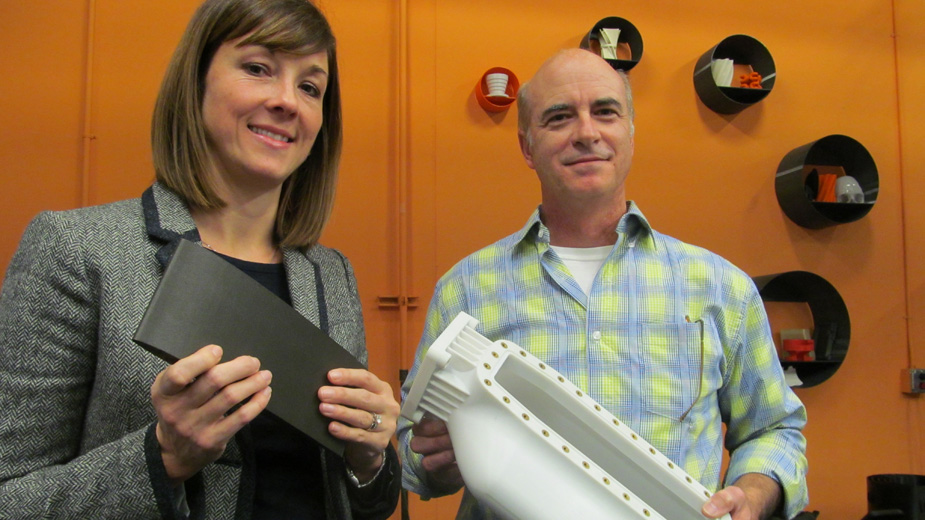Rp+m Develops New Applications for 3-D Printing
AVON LAKE, Ohio – What started as an idea to augment a large plastic-injection molding operation in Avon Lake, Ohio, is today a stand-alone business at the forefront of the additive manufacturing revolution.
Rapid Prototyping and Manufacturing LLC, better known as rp+m, began as a division of Thogus at that company’s plant west of Cleveland. In 2011, just as more attention was focused on the prospects of additive manufacturing and 3-D printing, Thogus spun off rp+m, says its president, Tracy Albers.
“We first got into additive manufacturing as a customer acquisition tool,” she says. Through 3-D printing, Thogus could test both form and function of injection-molding tools intended to result in longer life cycles and bigger returns. Instead, the owners discovered just how much science and research was needed in the field – considerable – and that its customer base was very different than Thogus.
The company started operating on its own in 2011 and was one of the initial members of America Makes.
There are many companies that contract 3-D printing services – they’re called service bureaus – but there are none Albers knows of that performs both contract additive manufacturing along with research and development. “Our expertise is in technology and process development,” she explains. “It enables more and more applications for the technology, not just making parts.”
Additive manufacturing is a process where someone designs or scans a part or component in a digital format. The data encompass information such as the precise size of the part, its dimensions and complexities. Those data are transferred to a 3-D printer, which automatically manufactures the component by building it from the ground up, layer-by-layer, rather than milling the part from a solid piece of metal or plastic.
Rp+m leases space in the front area of Thogus’ Avon Lake plant. There, a row of four 3-D printers, each roughly three refrigerators wide, are capable of “printing” components by using a variety of materials – in this case, a thermoplastic filament.
“The most capacity we have is for our fused deposition modeling, or FDM, space,” Albers says. Filament wound in a spool is placed into the machine. The wound plastic – akin to a thicker and larger version of the plastic cord used in a common weed trimmer – is fed into a chamber that heats and melts the plastic before it’s dispensed through a nozzle that moves precisely as instructed by the programmed design.
“It’s like a very over-engineered glue gun,” Albers explains. As the nozzle moves back and forth to its programmed coordinates, it dispenses the melted plastic, shaping it into the desired part. Essentially, the component is built from the ground up.
Albers says her company is the largest of its kind. “There are larger companies that have more capacity,” she says, “but they use the process for their own purposes.”
Rp+m not only contracts as a service bureau, it focuses on materials development for use in additive manufacturing technology. “We do printing, contract manufacturing or consulting work,” Albers relates. Among its customers are some of the largest manufacturers in northeastern Ohio, she adds. While rp+m works with materials such as plastics, the company also uses materials such as ceramics and metals on other machines, she says.
Another printer in a large display area uses a direct metal laser-sintering platform to create metallic parts. In this case, the device produces an array of
buttons made of titanium. “We’re taking a bed of metal material and melting it with a 400-watt laser,” Albers says. The laser moves over the metal to fuse it into custom-made buttons.
“We can print in titanium, stainless [steel] and aluminum,” she says. While it doesn’t make sense to use this technology for mass-produced parts identical to one another, there is increasing demand to use additive manufacturing for custom parts – say buttons created with a person’s initials inscribed. “There’s a lot of interest in additive manufacturing for mass-customization-type things,” she says.
Each quarter, rp+m hosts a design challenge among its engineers to come up with interesting projects that the company could pursue on its own, Albers says. “All of our team is focused on client-specific things,” she says, “but it’s fun to think about applying additive to something that could be ours.”
The company works closely with America Makes, Case Western Reserve University, where it has a presence, and government agencies such as the NASA Glenn Research Center on various research projects related to aerospace and other industries, Albers says.
What’s challenging is developing the proper materials suited to the additive manufacturing process that ensure its reliability in diverse industries, including aerospace, adds Tom Santelle, strategic program director.
“One of our focuses is materials scale-ups,” he says. Rp+m works with other research and development teams to create new, or “novel,” materials used in additive manufacturing. These materials, however, must be compliant with their respective industry standards, such as aerospace, he says.
“There’s one project we’re doing with the state of Ohio in which we’re developing six novel materials,” Santelle says. That project – geared toward aerospace – calls for developing these base materials to 3-D print parts that would ultimately be used in spacecraft. “Some are going to be incorporated into parts or components that are literally going to be in space by the end of the year,” he says.
Another project, this one in tandem with NASA Glenn in Cleveland, involves rp+m’s research devoted to creating materials for use in a non-metallic gas turbine engine for aerospace applications. “We’ve developed a thermoplastic material and a CMC – a ceramic matrix composite material,” Santelle says.
In these cases, the company works with a research partner that develops the base materials. Rp+m performs scale-up materials research while the end user – say Boeing or Lockheed – uses this material in the additive manufacturing process to develop parts. “We take materials that are lab-scale early-development and take them up to commercial readiness,” he says.
Some of the work the company does with America Makes is validating commercial materials for use in 3-D, says senior technologist Clark Patterson. “I handle a lot of the technological aspects of the business,” he says, “and a lot of my work surrounds new material development.”
As more materials become available, Albers says, additive manufacturing could expand into other industries but it does not threaten traditional methods of manufacturing.
“The hype cycle of additive is on the tail end,” Albers says. “For too many years, the consensus was that additive manufacturing and automation was going to replace everything. I assure you, it is not.”
Instead, the technology complements conventional manufacturing, especially when it comes to low-volume production of a particular component, she says, such as a short-run complex injection mold. Such a run normally would require a substantial upfront investment in tooling. “That makes sense,” she comments.
Albers acknowledges the technology is not without its drawbacks and limitations. “There’s a lot of R&D work to push these platforms further,” she says. “There’s still a big to-do list.”
Pictured: Tracy Albers and Tom Santelle show items printed at Rapid Prototyping and Manufacturing.
Copyright 2024 The Business Journal, Youngstown, Ohio.



